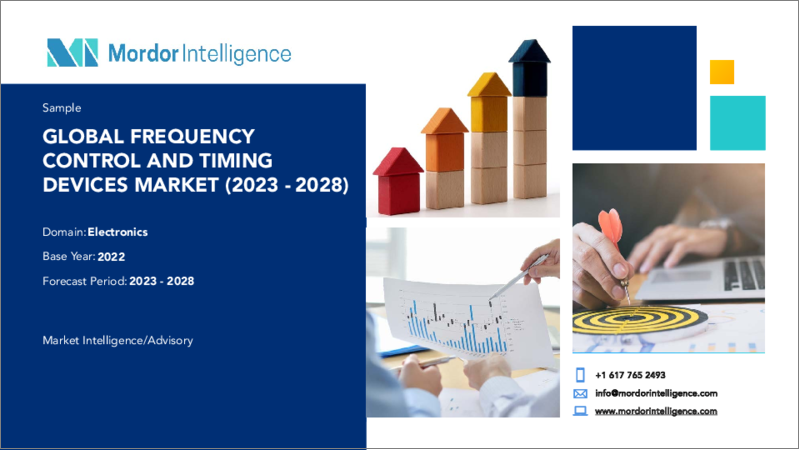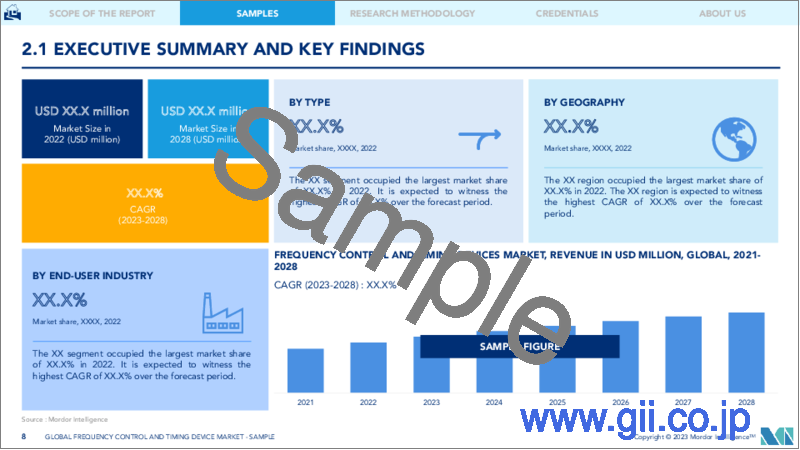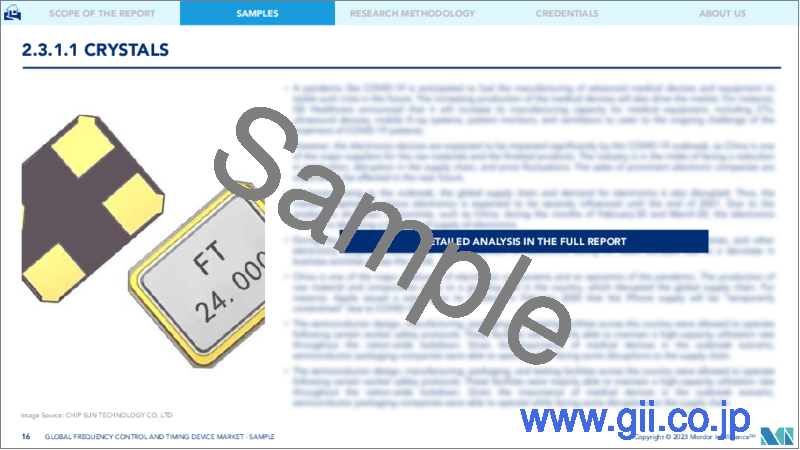|
|
市場調査レポート
商品コード
1135806
周波数制御とタイミングデバイスの世界市場- 成長、動向(2022年~2027年)Frequency Control and Timing Devices Market - Growth, Trends (2022 - 2027) |
||||||
|
● お客様のご希望に応じて、既存データの加工や未掲載情報(例:国別セグメント)の追加などの対応が可能です。 詳細はお問い合わせください。 |
|||||||
| 周波数制御とタイミングデバイスの世界市場- 成長、動向(2022年~2027年) |
|
出版日: 2022年10月13日
発行: Mordor Intelligence
ページ情報: 英文 120 Pages
納期: 2~3営業日
|
- 全表示
- 概要
- 目次
周波数制御とタイミングデバイスの世界市場は、予測期間(2022年~2027年)にCAGR 8.95%で成長すると予測されています。
COVID-19の発生は、世界の電子産業のサプライチェーンに大きな影響を与え、調査した市場の需要や成長に影響を与えています。ほとんどの電子分野のサプライチェーンは、あらゆる生産レベルでCOVID-19の実質的な影響を感じた。2020年には、多くの工場がしばらく操業を停止したり、生産能力を低下させたりし、サプライヤーは生産が制限されているため、需要に追いつくのに苦労しました。2021年には多くの国で第二波が示されたように、その影響は今年の半ばまで続くと予想されます。マザーボードの不足はメーカーに大きなプレッシャーを与えているが、水晶振動子やMEMS発振器の原材料も同様に不足しています。
主なハイライト
- 利便性向上のため、リモートキーレスエントリーなどのワイヤレス通信の応用が進んでいます。水晶振動子や発振器などの水晶デバイスは、環境変化に対して高い安定性を持っています。そのため、電子回路における周波数制御デバイスとしての利用が拡大しています。水晶振動子や発振器の自動車への応用は、予測期間中に拡大することが予想されます。
- さらに、水晶振動子を用いたタイミングデバイスは、ブレーキ制御システム、アンチロックシステム、エアバッグやタイヤ空気圧監視システム(TPMS)などの安全アプリケーションに広く使用されています。精度に対する要求、安全アプリケーションに対する規制の強化、高速データ伝送の必要性などが、タイミング・デバイスの採用を促進しています。
- 車載システムの開発者は、衝撃や振動の問題を抱えやすい共振器や発振器のタイミング・ソリューションを使用しています。ADASの出現により、クロッキング、複雑なデータ取得レート、低ジッタの基準クロックに対する要求が高まっています。調査対象市場のベンダーは、今後数年間、こうしたソリューションの開発・提供に注力することが予想されます。
- 例えば、エプソンは、低ジッタ発振器の利用可能な最高周波数を拡張しました。例えば、エプソンは、低ジッター発振器の使用可能周波数の上限を200MHzから500MHzに引き上げました。この動きは、5G通信トラフィックの増加により予想される高速・広帯域のネットワーク要件に合致するものでした。
- さらに、各種周波数制御発振器の需要は、スマートフォンアプリケーションにおけるWi-FiおよびBluetoothコンボチップセットの使用を向上させています。民生機器におけるこれらのアプリケーションのサポートが増加していることを考慮すると、民生機器セグメントは予測期間中に強い潜在的成長を遂げると予想されます。さらに、IoTなどの動向により、民生用電子機器に使用されるRF通信やコンポーネントの進歩が進んでいることも、調査対象市場の成長を拡大させています。なお、ファーウェイのスマートフォン「P30」シリーズには、京セラの水晶発振器が搭載されています。
主な市場動向
自動車産業セグメントが大きな市場シェアを占める見込み
- 自動車分野では、周波数制御デバイスやタイミングデバイスがADAS(先進運転支援システム)、LiDAR(Light Detection and Ranging)、自律走行、インフォテインメントシステム、車載イーサネット、エンジン制御モジュール、メータークラスタなどに使用されています。ジッターフリーの水晶発振器の需要が増加していることは、車載用アプリケーションの需要が拡大していることを示しています。
- エプソンのSG2520CAAは、2020年半ばにCMOS出力のSPXO(Simple Packaged Crystal Oscillator)とTCXO(Temperature Compensated Crystal Oscillator)を発売しました。車載用や高信頼性アプリケーションに最適で、AEC-Q200に適合しています。本製品は、低消費電流、1.6V~3.63Vの幅広い動作電圧、-40℃~85℃の幅広い動作温度を実現しています。自動車分野では、カメラ、LiDAR(Light Detection and Ranging)、レーダー、ネットワーク、オーディオ、時計、メーター、クラスター、ボディコントロール(BCM)などの車載インフォテインメントシステムなど、ADAS(先進運転支援システム)に使用されています。
- 最近、2022年の初めに、COVID-19の大流行の影響として、ホンダ、フォード、トヨタ、BWM、GMなどの自動車会社が新車の生産量を減らしたり、生産ラインを完全に停止させるという複数の報道がなされました。自動車用半導体の不足が原因であり、通常レベルに戻すには6カ月を要するとされています。
- また、自動車メーカー各社は、車載用の低ジッター・任意の周波数のクロックジェネレーターやバッファなど、簡素なクロックツリー設計にシフトしていることが確認されています。そのため、発振器の数を増やすのではなく、クロックジェネレータやバッファがより効果的に機能するようになります。
- 2021年12月、先進的な半導体ソリューションのプレミア・サプライヤーであるルネサスエレクトロニクス株式会社は、次世代の電子・電気(E/E)アーキテクチャにおけるエッジ進化をサポートする車載アクチュエータおよびセンサ制御アプリケーション向けに設計された新しいタイミングデバイスとコントローラ2製品を発表しました。新製品「RL78/F24」と「RL78/F23」により、ルネサスは低消費電力16ビット・コントローラおよびタイミングデバイスのRL78ファミリを拡充し、車載用ポートフォリオを強化し、アクチュエータからゾーンコントロールまでのシステム向けに、高い信頼性とパフォーマンスのソリューションを顧客に提供することが可能になります。
アジア太平洋地域が重要な市場シェアを占める
- 中国は、民生用電子機器、半導体、その他の通信機器や装置の製造において強力な地位を占めており、周波数制御とタイミングデバイスの世界の主要市場の1つとなっています。中国は、水晶振動子やMEMS発振器の世界の消費国であり、生産国でもあります。過去数年間、同国では温度補償型発振器の採用が最も多く、これは同国が高度な家電製品に特化した専用発振器を開発していたためです。
- 2021年のMobile World Congress Shanghaiの期間中、中国の通信事業者が世界最大の5Gネットワークを構築するために2600億人民元以上を投資したと発表しました。通信事業収益の成長率は大幅に上昇しました。工業情報化部(MIIT)の発表によると、2021年の通信部門は前年比8%増の1兆4700億人民元(約2324億3000万米ドル)で、成長率は2020年から4・1ポイントアップしています。
- さらに、韓国にはLGやサムスンなど、地域最大級の家電メーカーも存在します。これらの企業は、世界レベルで周波数制御およびタイミングデバイスの重要な採用企業となっています。LG電子やサムスン電子など、韓国の家電メーカーの多くは、製造拠点を他国に移転しています。この傾向は、貿易保護主義の高まりと、最低賃金の異例の引き上げに代表される労働市場の硬直化・低生産性により、さらに加速すると予想されます。
- また、東南アジア諸国連合(ASEAN)加盟国は5Gのマスタープランを策定し続けており、例えばシンガポールは2025年までに5Gを全国に普及させることを目指しています。5Gは、消費者により速い接続速度、低遅延、広帯域を提供するだけでなく、IoT、スマートシティ、促進要因レスカー、ロボット家電、拡張現実などの幅広い新しいデジタルアプリケーションを可能にする革命的なアップグレードとして注目されています。これらの取り組みが、この地域の研究対象市場をさらに押し上げることになります。
- さらに、シンガポールのInfocomm Media Development Authorityによると、同国は2021年に2つの独立した5Gネットワークを立ち上げることになっています。2022年末には国土の半分を、2025年末には国土全体をカバーできる5Gネットワークを構築する予定です。このプロジェクトは現在、Singtel、StarHub、M1が設立した関連会社が入札を行っています。他のモバイルネットワーク事業者は、5Gネットワークの使用権を購入することになります。
競合情勢
周波数制御およびタイミングデバイスの世界市場は、数多くの発振器および共振器メーカーが製品を提供し、著しく断片化されています。各社は、持続可能な環境の成長を促進し、環境災害を防止するために、製品と技術に継続的に投資しています。同市場の主要企業は、革新的な新製品を投入し、パートナーシップやコラボレーションを形成して競争優位性を獲得しています。
- 2022年1月-ID Quantiqueは、新しいID1000 Time Controllerデバイスを発表しました。ID Quantique(IDQ)のフォトニック量子センシングシリーズの最新製品で、単一光子実験とアプリケーションのための統一された力です。このオールインワンのタイムタグ、コインシデンス相関、遅延/パルス生成システムにより、より多くのカウント、より少ない後処理、単一光子実験へのより速い反応を提供します。
- 2021年2月-MEMSタイミングを提供するSiTime Corporationは、温度補償型シリコンMEMSオシレータ(TCXO)「SiT5008」を発表しました。SiT5008は、インターネットに接続されたオーディオ・ビデオ、オーバー・ザ・トップ・ストリーミング機器、産業用スマートメーターなど、低電力の無線接続を使用するコネクテッド・コンスーマー機器やIoT機器に最適です。さらに、プログラマブルな機能、±2ppm~±10ppmの周波数安定度、環境耐性を小型パッケージで提供します。
その他の特典
- エクセル形式の市場予測(ME)シート
- 3ヶ月間のアナリスト・サポート
目次
第1章 イントロダクション
- 調査の前提条件と市場の定義
- 調査対象範囲
第2章 調査手法
第3章 エグゼクティブサマリー
第4章 マーケットインサイト
- 市場概要
- 産業の魅力- ポーターのファイブフォース分析
- 供給企業の交渉力
- 買い手の交渉力
- 新規参入業者の脅威
- 代替品の脅威
- 競争企業間の敵対関係
- 産業バリューチェーン分析
- COVID-19が市場に与える影響評価
第5章 市場の力学
- 市場促進要因
- 世界の5G導入の拡大
- 先進的な自動車アプリケーションからの需要増加
- 市場抑制要因
- 高い開発コスト
第6章 市場セグメンテーション
- タイプ
- 水晶振動子
- 発振器
- 温度補償型水晶発振器(TCXO)
- 電圧制御水晶発振器(VCXO)
- 恒温槽付水晶発振器(OCXO)
- MEMS発振器
- その他の発振器
- 共振器
- エンドユーザー産業
- 車載用
- コンピュータ/周辺機器
- 通信/サーバー/データストレージ
- 民生用電子機器
- 工業
- その他のエンドユーザー
- 地域別
- 北米
- 欧州
- アジア太平洋地域
- 世界のその他の地域
第7章 競合情勢
- 企業プロファイル
- Murata Manufacturing Co. Ltd
- Kyocera Corporation
- Rakon Ltd
- Microchip Technology Inc.
- TXC Corporation
- Seiko Epson Corporation
- Daishinku Corporation
- Hosonic Electronic Co. Ltd
- Nihon Dempa Kogyo(NDK)Co. Ltd
- SiTime Corporation
- STMicroelectronics International N.V.
- Texas Instruments Inc.
- NXP Semiconductors
第8章 投資分析
第9章 市場の将来性
The Global Frequency Control and Timing Devices Market is expected to witness growth at a CAGR of 8.95% over the forecast period (2022- 2027). The COVID-19 outbreak has affected the global electronics industry supply chain significantly, affecting the demand and growth in the studied market. Supply chains across the most electronic sectors felt the substantial impact of COVID-19 at every production level. In 2020, many factories halted for a while or reduced their capacity, and suppliers struggled to keep up with demand due to limited production. As the second wave was witnessed in many countries in 2021, that effect is expected to continue until mid this year. Motherboard shortages are placing heavy pressure on manufacturers, but so are similar scarcity of raw materials for crystal and MEMS oscillators.
Key Highlights
- The increasing demand for convenience is driving the application of wireless interconnections, such as remote keyless entry. Crystal devices, such as quartz crystal units and oscillators, have higher stability against environmental changes. Therefore, they are increasingly used as frequency control devices in electronic circuits. The application of crystal units and oscillators in automobiles is expected to grow during the forecast period.
- Moreover, crystal-based timing devices are widely used in safety applications, such as brake control systems, anti-locking systems, and airbag and tire pressure monitoring systems (TPMS). The demand for precision, improving regulations for safety applications, and the necessity for fast data transmission are driving the adoption of timing devices.
- Automotive system developers use resonators and oscillator timing solutions that are prone to shock and vibration issues. With the advent of ADAS, the requirement for clocking, complex data acquisition rates, and low jitter reference clocks is increasing. Vendors in the market studied are expected to focus on developing and offering such solutions over the coming years.
- For instance, Epson extended the highest available frequency on the low-jitter oscillator. The company increased the upper-frequency limit to 500 MHz from 200 MHz. This move aligned with the expected network requirement for high speed and wideband due to the 5G communication traffic growth.
- Further, the demand for various frequency control oscillators has improved the use of Wi-Fi and Bluetooth combo chipsets in smartphone applications. Considering the increasing support for these applications in consumer products, the consumer electronics segment is expected to see strong potential growth during the forecast period. Furthermore, the growing advancement of RF communication and component used in consumer electronics, owing to trends like IoT, is also expanding the studied market growth. Huawei's new series of smartphones, like the P30, include crystal oscillators supplied by Japan-based Kyocera.
Key Market Trends
Automotive Industry Segment is Expected to Hold a Significant Market Share
- In the automotive sector, frequency control and timing devices are used for ADAS (Advanced Driver Assistance Systems), Light Detection and Ranging (LiDAR), autonomous driving, infotainment systems, in-vehicle ethernet, engine control modules, and instrument clusters, among others. The increasing demand for jitter-free crystal oscillators is indicative of the growing demand for automotive applications.
- In mid-2020, Epson's SG2520CAA launched a Simple Packaged Crystal Oscillator (SPXO) and Temperature Compensated Crystal Oscillator (TCXO) with CMOS output. Being ideal for automotive and high-reliability applications, it conforms to AEC-Q200. This device has low current consumption, a wide operating voltage from 1.6 V to 3.63 V, and wide operating temperatures ranging from -40 °C to 85 °C. Within the automotive sector, it finds applications in ADAS (Advanced Driver Assistance Systems); that is, Camera, LiDAR (Light Detection and Ranging), radar, networking & Automotive Infotainment systems, such as audio, clock, meter, cluster, and body control (BCM).
- Recently, at the beginning of 2022, as an impact of the COVID-19 pandemic, multiple reports indicated that automotive companies, such as Honda, Ford, Toyota, BWM, and GM would reduce the production outputs of new vehicles or stop production lines entirely. The cause of the halt stems from a shortage of automotive-grade semiconductors, with six months being a tentative timeline to get levels back to normal.
- Further, the automobile manufacturers are observed to be shifting to simplified clock tree designs, such as automotive-grade low-jitter, any-frequency clock generators, and buffers. Hence, instead of deploying more numbers of oscillators, clock generators and buffers will work more effectively.
- In December 2021, Renesas Electronics Corporation, a premier supplier of advanced semiconductor solutions, announced two new timing devices and controllers designed for automotive actuator and sensor control applications supporting edge evolution in next-generation electronic and electrical (E/E) architecture. With the new RL78/F24 and RL78/F23, Renesas expands its RL78 Family of low-power 16-bit controllers and timing devices and strengthens its broader automotive portfolio, offering customers highly reliable, high-performance solutions for systems ranging from actuators to zone control.
Asia-Pacific to Hold Significant Market Share
- China is one of the key markets for frequency control and timing devices globally, owing to its strong position in consumer electronics, semiconductors, and other telecommunications devices and equipment manufacturing. The country is one of the significant consumers and producers of global crystal and MEMS oscillators. Over the past few years, the country's adoption of temperature-compensated oscillators was the highest in the country, as the country was developing specialized oscillators specifically for advanced consumer electronics products.
- During Mobile World Congress Shanghai 2021, the government announced that Chinese carriers had invested more than CNY 260 billion to build the world's largest 5G network. The growth rate of telecom business revenue has increased significantly. As per the Ministry of Industry and Information Technology (MIIT), The telecom sector rose 8 percent year-on-year to CNY 1.47 trillion (about USD 232.43 billion) in 2021, with the growth rate up 4.1 percentage points from 2020.
- Moreover, South Korea is also home to some of the largest consumer electronic companies in the region, such as LG and Samsung. These companies are some of the significant adopters of frequency control and timing devices at the global level. Many South Korean consumer electronics manufacturers, including LG Electronics and Samsung Electronics, are relocating their manufacturing facilities to other countries. The trend is expected to accelerate due to mounting trade protectionism and the rigidity and low productivity of the country's labor market, represented by an exceptionally rapid increase in the minimum wage.
- Additionally, Members of the Association of Southeast Asian Nations continue to roll out their 5G masterplans, with Singapore, for example, still on track to achieve nationwide 5G coverage by 2025. As well as providing consumers with faster connection speeds, lower latency, and more bandwidth, 5G has been touted as a revolutionary upgrade that would enable a wide range of new digital applications like IoT, smart cities, driverless cars, robotic appliances, and augmented reality. These initiatives further boost the studied market for the region.
- Further, according to Singapore's Infocomm Media Development Authority, the country was to launch two standalone 5G networks in 2021. It will build a 5G network that can cover half of the country by the end of 2022 and the entire country by the end of 2025. This project is currently bid on by an associated company formed by Singtel, StarHub, and M1. Other mobile network operators would purchase the right to use the 5G network.
Competitive Landscape
The Global Frequency Control and Timing Devices Market are significantly fragmented, with numerous oscillator and resonator-manufacturers providing the product. The companies continuously invest in the product and technology to promote sustainable environmental growth and prevent environmental hazards. Key players in this market are introducing new innovative products and forming partnerships and collaborations to gain competitive advantages.
- January 2022 - ID Quantique introduced the new ID1000 Time Controller devices: the latest addition to ID Quantique's (IDQ) Photonic Quantum Sensing range, a unifying force for single-photon experiments and applications. It provides count more, post-process less, and reacts faster to single-photon experiments with this all-in-one time-tagging, coincidence correlation, and delay/pulse generation system.
- February 2021 - SiTime Corporation, a provider of MEMS timing, announced the SiT5008 temperature-compensated silicon MEMS oscillator (TCXO). The SiT5008 is ideal for connected consumer and IoT devices such as Internet-connected audio-video, over-the-top streaming devices, industrial smart meters, and other devices that use low-power wireless connectivity. Additionally, it offers programmable features, ±2 ppm to ±10 ppm frequency stability, environmental resilience in a small package.
Additional Benefits:
- The market estimate (ME) sheet in Excel format
- 3 months of analyst support
TABLE OF CONTENTS
1 INTRODUCTION
- 1.1 Study Assumptions and Market Definitions
- 1.2 Scope of the Study
2 RESEARCH METHODOLOGY
3 EXECUTIVE SUMMARY
4 MARKET INSIGHTS
- 4.1 Market Overview
- 4.2 Industry Attractiveness - Porter's Five Forces Analysis
- 4.2.1 Bargaining Power of Suppliers
- 4.2.2 Bargaining Power of Buyers
- 4.2.3 Threat of New Entrants
- 4.2.4 Threat of Substitute Products
- 4.2.5 Intensity of Competitive Rivalry
- 4.3 Industry Value Chain Analysis
- 4.4 Assessment of the Impact of COVID -19 on the Market
5 MARKET DYNAMICS
- 5.1 Market Drivers
- 5.1.1 Growing 5G Adoption Across the World
- 5.1.2 Rising Demand from Advanced Automotive Applications
- 5.2 Market Restraints
- 5.2.1 High Cost of Development
6 MARKET SEGMENTATION
- 6.1 Type
- 6.1.1 Crystals
- 6.1.2 Oscillators
- 6.1.2.1 Temperature Compensated Crystal Oscillator (TCXO)
- 6.1.2.2 Voltage-controlled Crystal Oscillator (VCXO)
- 6.1.2.3 Oven-controlled Crystal Oscillator (OCXO)
- 6.1.2.4 MEMS Oscillator
- 6.1.2.5 Other Types of Oscillators
- 6.1.3 Resonators
- 6.2 End-User Industry
- 6.2.1 Automotive
- 6.2.2 Computer & Peripherals
- 6.2.3 Communications/Server/Data Storage
- 6.2.4 Consumer Electronics
- 6.2.5 Industrial
- 6.2.6 Other End Users
- 6.3 Geography
- 6.3.1 North America
- 6.3.2 Europe
- 6.3.3 Asia Pacific
- 6.3.4 Rest of the World
7 COMPETITIVE LANDSCAPE
- 7.1 Company Profiles
- 7.1.1 Murata Manufacturing Co. Ltd
- 7.1.2 Kyocera Corporation
- 7.1.3 Rakon Ltd
- 7.1.4 Microchip Technology Inc.
- 7.1.5 TXC Corporation
- 7.1.6 Seiko Epson Corporation
- 7.1.7 Daishinku Corporation
- 7.1.8 Hosonic Electronic Co. Ltd
- 7.1.9 Nihon Dempa Kogyo (NDK) Co. Ltd
- 7.1.10 SiTime Corporation
- 7.1.11 STMicroelectronics International N.V.
- 7.1.12 Texas Instruments Inc.
- 7.1.13 NXP Semiconductors




